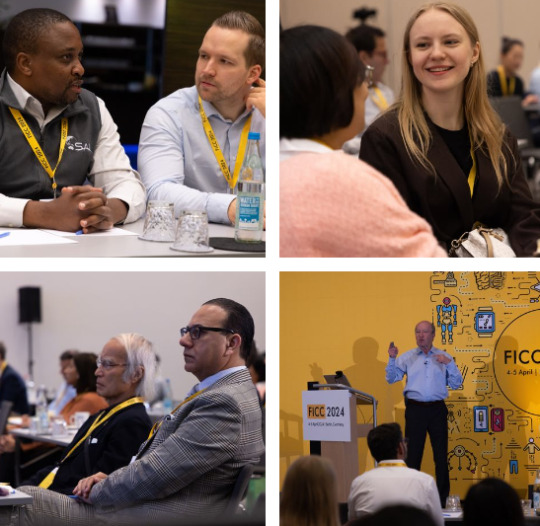#Data Science conference
Explore tagged Tumblr posts
Text
Join top Cyber Security Conferences
Stay updated on emerging cyber threats and defense strategies. Network with global professionals and industry pioneers. Secure your spot today and enhance your cybersecurity expertise!
Contact Us :- Call :- 9990902003 Email :- [email protected] For Register :-https://saiconference.com/ficc
#Cyber Security Conferences#CyberSecurityConferences#data science conference#robotics conference#technology conference
0 notes
Text
being good at my job is weird. i decided on friday to look at some voyager 2 data like dig into 40 year old data and i just knew how to do it. they’re going to let me organise a conference.
#to be clear i am looking at the voyager data to get a better understanding of the old papers#i wouldn’t do analysis on it without taking to one of the old science team guys#but literally i pitched a conference to a bunch of bigwigs at work and they’re just going to let me do it#my boss is starting to treat me like a peer instead of someone to mentor
7 notes
·
View notes
Text
Day 52/100 days of productivity | Thu 11 Apr, 2024
Had lots of meetings at work
Finished my coding task for Friday
Practiced for my conference presentation next week
Continued working on my blog article
4 notes
·
View notes
Text
Elaine Liu: Charging ahead
New Post has been published on https://thedigitalinsider.com/elaine-liu-charging-ahead/
Elaine Liu: Charging ahead


MIT senior Elaine Siyu Liu doesn’t own an electric car, or any car. But she sees the impact of electric vehicles (EVs) and renewables on the grid as two pieces of an energy puzzle she wants to solve.
The U.S. Department of Energy reports that the number of public and private EV charging ports nearly doubled in the past three years, and many more are in the works. Users expect to plug in at their convenience, charge up, and drive away. But what if the grid can’t handle it?
Electricity demand, long stagnant in the United States, has spiked due to EVs, data centers that drive artificial intelligence, and industry. Grid planners forecast an increase of 2.6 percent to 4.7 percent in electricity demand over the next five years, according to data reported to federal regulators. Everyone from EV charging-station operators to utility-system operators needs help navigating a system in flux.
That’s where Liu’s work comes in.
Liu, who is studying mathematics and electrical engineering and computer science (EECS), is interested in distribution — how to get electricity from a centralized location to consumers. “I see power systems as a good venue for theoretical research as an application tool,” she says. “I’m interested in it because I’m familiar with the optimization and probability techniques used to map this level of problem.”
Liu grew up in Beijing, then after middle school moved with her parents to Canada and enrolled in a prep school in Oakville, Ontario, 30 miles outside Toronto.
Liu stumbled upon an opportunity to take part in a regional math competition and eventually started a math club, but at the time, the school’s culture surrounding math surprised her. Being exposed to what seemed to be some students’ aversion to math, she says, “I don’t think my feelings about math changed. I think my feelings about how people feel about math changed.”
Liu brought her passion for math to MIT. The summer after her sophomore year, she took on the first of the two Undergraduate Research Opportunity Program projects she completed with electric power system expert Marija Ilić, a joint adjunct professor in EECS and a senior research scientist at the MIT Laboratory for Information and Decision Systems.
Predicting the grid
Since 2022, with the help of funding from the MIT Energy Initiative (MITEI), Liu has been working with Ilić on identifying ways in which the grid is challenged.
One factor is the addition of renewables to the energy pipeline. A gap in wind or sun might cause a lag in power generation. If this lag occurs during peak demand, it could mean trouble for a grid already taxed by extreme weather and other unforeseen events.
If you think of the grid as a network of dozens of interconnected parts, once an element in the network fails — say, a tree downs a transmission line — the electricity that used to go through that line needs to be rerouted. This may overload other lines, creating what’s known as a cascade failure.
“This all happens really quickly and has very large downstream effects,” Liu says. “Millions of people will have instant blackouts.”
Even if the system can handle a single downed line, Liu notes that “the nuance is that there are now a lot of renewables, and renewables are less predictable. You can’t predict a gap in wind or sun. When such things happen, there’s suddenly not enough generation and too much demand. So the same kind of failure would happen, but on a larger and more uncontrollable scale.”
Renewables’ varying output has the added complication of causing voltage fluctuations. “We plug in our devices expecting a voltage of 110, but because of oscillations, you will never get exactly 110,” Liu says. “So even when you can deliver enough electricity, if you can’t deliver it at the specific voltage level that is required, that’s a problem.”
Liu and Ilić are building a model to predict how and when the grid might fail. Lacking access to privatized data, Liu runs her models with European industry data and test cases made available to universities. “I have a fake power grid that I run my experiments on,” she says. “You can take the same tool and run it on the real power grid.”
Liu’s model predicts cascade failures as they evolve. Supply from a wind generator, for example, might drop precipitously over the course of an hour. The model analyzes which substations and which households will be affected. “After we know we need to do something, this prediction tool can enable system operators to strategically intervene ahead of time,” Liu says.
Dictating price and power
Last year, Liu turned her attention to EVs, which provide a different kind of challenge than renewables.
In 2022, S&P Global reported that lawmakers argued that the U.S. Federal Energy Regulatory Commission’s (FERC) wholesale power rate structure was unfair for EV charging station operators.
In addition to operators paying by the kilowatt-hour, some also pay more for electricity during peak demand hours. Only a few EVs charging up during those hours could result in higher costs for the operator even if their overall energy use is low.
Anticipating how much power EVs will need is more complex than predicting energy needed for, say, heating and cooling. Unlike buildings, EVs move around, making it difficult to predict energy consumption at any given time. “If users don’t like the price at one charging station or how long the line is, they’ll go somewhere else,” Liu says. “Where to allocate EV chargers is a problem that a lot of people are dealing with right now.”
One approach would be for FERC to dictate to EV users when and where to charge and what price they’ll pay. To Liu, this isn’t an attractive option. “No one likes to be told what to do,” she says.
Liu is looking at optimizing a market-based solution that would be acceptable to top-level energy producers — wind and solar farms and nuclear plants — all the way down to the municipal aggregators that secure electricity at competitive rates and oversee distribution to the consumer.
Analyzing the location, movement, and behavior patterns of all the EVs driven daily in Boston and other major energy hubs, she notes, could help demand aggregators determine where to place EV chargers and how much to charge consumers, akin to Walmart deciding how much to mark up wholesale eggs in different markets.
Last year, Liu presented the work at MITEI’s annual research conference. This spring, Liu and Ilić are submitting a paper on the market optimization analysis to a journal of the Institute of Electrical and Electronics Engineers.
Liu has come to terms with her early introduction to attitudes toward STEM that struck her as markedly different from those in China. She says, “I think the (prep) school had a very strong ‘math is for nerds’ vibe, especially for girls. There was a ‘why are you giving yourself more work?’ kind of mentality. But over time, I just learned to disregard that.”
After graduation, Liu, the only undergraduate researcher in Ilić’s MIT Electric Energy Systems Group, plans to apply to fellowships and graduate programs in EECS, applied math, and operations research.
Based on her analysis, Liu says that the market could effectively determine the price and availability of charging stations. Offering incentives for EV owners to charge during the day instead of at night when demand is high could help avoid grid overload and prevent extra costs to operators. “People would still retain the ability to go to a different charging station if they chose to,” she says. “I’m arguing that this works.”
#2022#amp#Analysis#approach#artificial#Artificial Intelligence#attention#Behavior#Building#buildings#Canada#cascade#challenge#China#competition#computer#Computer Science#conference#consumers#cooling#course#data#Data Centers#devices#effects#electric power#electric vehicles#Electrical engineering and computer science (EECS)#electricity#Electronics
2 notes
·
View notes
Text
rande successo per la Conferenza Esri Italia 2025: due giornate tra intelligenza artificiale, digital twin e la presentazione del libro sui viaggi di Papa Francesco. Scopri di più su Alessandria today.
#Alessandria today#Ama#Andrea Benedetti#Annalisa Barla#ArcGIS#AUBAC#città intelligenti#conferenza Roma#data science#dati territoriali#Digital Twin#Esri Conference 2025#Esri Italia#Esri Professional Summit#Esri Stories#geoAI#geointelligenza#geolocalizzazione#Geosmartcampus#GIS#Google News#greenaccord#Innovazione digitale#Intelligenza artificiale#Istituto Idrografico Marina#italianewsmedia.com#Lava#libro interattivo#Microsoft#Papa Bergoglio
0 notes
Text
Machine Learning And Big Data: Key Innovations From Big Data Summit Canada
Machine learning and big data have become integral to modern business strategies, transforming how organisations operate, make decisions, and interact with customers. At the Big Data Summit Canada, attendees are introduced to the latest innovations in these fields, gaining insights into how businesses can harness the power of machine learning to analyse vast datasets and improve operational efficiency.
The Role of Machine Learning in Big Data
Machine learning has revolutionised the way businesses process and analyse data. Rather than relying on traditional methods of data analysis, machine learning allows systems to learn from large datasets and automatically make predictions or decisions based on patterns it detects. At the Data Analytics Summit, experts explore how businesses can implement machine learning models to uncover hidden insights and optimise processes.
At the summit, speakers highlight real-world applications where machine learning has made significant improvements. For instance, industries like healthcare, finance, and retail are using machine learning algorithms to improve customer segmentation, predict market trends, and even detect fraudulent activities. With machine learning, businesses can unlock the true potential of big data, turning complex and voluminous information into actionable insights.
Innovations in Big Data Analytics
Big data analytics is another focal point at the Big Data Summit Canada. The summit dives deep into how businesses can manage and analyse massive amounts of data more efficiently. Innovations in big data tools and platforms, such as cloud-based solutions and advanced data visualisation techniques, are making it easier for companies to handle large datasets. These innovations allow businesses to make faster, data-driven decisions, improving customer experiences and driving growth.
One notable trend showcased at the summit is the integration of machine learning with big data analytics. This combination allows businesses to create more accurate models for predictive analysis, enabling proactive decision-making. The ability to automate data analysis through machine learning not only improves speed but also enhances accuracy, ensuring better outcomes for businesses.
AI Conference Canada: Exploring the Future of AI
In addition to big data and machine learning, the AI Conference Canada is another key highlight at the summit. Here, industry leaders present the latest advancements in artificial intelligence and its impact on big data. AI’s potential to process and analyse data more efficiently is making it indispensable for businesses looking to stay competitive in a data-driven world. From automation to personalisation, AI is helping companies deliver enhanced services and achieve more accurate insights from their data.
Conclusion
The Big Data Summit Canada offers a unique opportunity for data professionals to explore cutting-edge innovations in machine learning and big data analytics. With real-world applications and expert insights, attendees can learn how to leverage these technologies to transform their organisations. Whether through machine learning or AI, the future of big data is bright, and the summit provides the knowledge needed to stay ahead in this rapidly evolving field.

#AI Conference Toronto#AI Toronto Conference#Tech Data Canada#Data Science In Toronto#Toronto Ai Conference
0 notes
Text
Gethsemane Enertech ERP Solution: Revolutionizing Energy Efficiency through AI, IoT & Data Science
Overview of Energy Efficiency in Ghana and Africa Energy efficiency is increasingly becoming a focal point in the energy sector, particularly in developing regions like Ghana and Africa, where energy demand is growing rapidly due to economic expansion and population growth. In these regions, energy efficiency is not just about reducing costs but also about enhancing energy security, reducing…

View On WordPress
#AI#ESG#IoT#ACEP#Africa#Climate Change#Coronavirus#Data Science#Energy Efficiency#Future of energy Conference 2024#Gethsemane Enertech ERP Solution#Ghana#GodRules#Green finance#Impact Investing#ImpactofCovid19#LoveofGod#Oil and gas#Teamwork
0 notes
Text
“new york is where all the misfits and black sheep go” sounds so corny until it’s a 40-something gay man saying this to you while drunk. then it feels so real
#he’s drunk. i am mildly intoxicated lol#i feel like i’m in rent#or across the universe or something#yes i made new friends at karaoke and am out stupid late again. what of it#i have to get up early for a women in data science conference too rip#m.txt
1 note
·
View note
Text

#EventMe - Artificial Intelligence Conference 2023
The Artificial Intelligence Conference in South Africa is a major event focusing on the practical applications of AI for businesses. It aims to assist business leaders, data scientists, and engineers in effectively implementing their AI projects.
#gentlemans code#event me#events#artificial intelligence#artificial intelligence conference#conference#business#the maslow#hotel#Sandton#south africa#data science#computer engineering
1 note
·
View note
Text
Join Data Science Conference for Cutting-Edge Insights

Experience the renowned Data Science Conference by SAI Conference, where experts explore advancements in AI, machine learning, and big data. Engage with groundbreaking research and innovative ideas driving data-driven decision-making. Don't miss this opportunity to network with global professionals and expand your knowledge of the latest trends shaping the future of data science.
Contact Us :- Email :- [email protected] For Register :-https://saiconference.com/ficc
0 notes
Text
While you were sleeping ...
Federal judge puts back funding to USAID
Federal judge demands US put back health related federal websites
Judge Tanya Chutkan investigating Elon Musk's ability to run DOGE
The Department of Energy blocks firings of hundreds of employees who work for a key agency maintaining the U.S. nuclear weapons stockpile
Federal judge stops Trump from sending detainees to Cuba
Federal judge stops Trump from shutting down Consumer Protection Agency
DOGE now at CMS which covers Medicare, Medicaid, the Children's Health Insurance Program, and the Health Insurance Marketplace and are allied with Rachel Riley who worked at privatizing healthcare under Trump's first term.
Trump seeks to gut the National Oceanic and Atmospheric Administration and privatize the nation's weather reports and news
Judge blocks DOGE from sensitive Treasury Dept payment system, system being studied and re-programmed after DOGE invasion. expected to finish in August 25.
DOGE database on DOGE site found compromised, anyone can open and edit
Hundreds of federal workers illegally 'fired' from FEMA, DHS, CIS, CPA, the Coast Guard, USCIS, DHS' Science and Technology Directorate, the VA, Education and the US Forestry Service as well as half of the CDC Epidemic Intelligence Service, The Indian (Native American) Health Service. Centers for Medicare and Medicaid Services and the National Institutes for Health, HUD and NOAA.
There have been illegal mass firings of 'probationary' federal employees, those who have just taken on jobs up to those who have were hired 2 years ago.
After seven prosecutors quit refusing to give a Trump deal to NYC mayor, prosecutors put into room and all told they would be fired unless a prosecutor signed off on the deal - Eric Adams case has been dropped and as a result, Adams is allowing Trump immigration to invade NYC.
Trump signs order to block funding for schools that mandate Covid vaccines
Trump has already captured funds to house the homeless in NYC that were disbursed by FEMA
Elon Musk has charged the US gov 16 million to hack at government departments so far.
Elon Musk was granted a 400million deal to sell the US gov cybertrucks
Elon Musk is now going after NASA, despite being a contractor for NASA, Trump says Musk will 'police' his own conflicts of interest.
Trump inserts himself into 'negotiations' between Russia and Ukraine, siding with Russia and not guaranteeing that Ukraine will return to pre-war borders.
Apparently at negotiations, US handed President Zelenskyy a note (mafia style) seeking half of Ukraine's mineral rights, which Zelenskyy refused to acknowlege.
at Munich Security Conference VP Vance pushes the right-wing in Europe, shocking and angering NATO allies, changing US policy towards Putin and China. Trump now says there is no US intent to 'beat China'.
FAKE DOGE 'employees' appear in San Francisco city hall demanding access to state systems and data, leaving when confronted.
Trump makes himself head of the Kennedy Center for the Arts many staff resign and many artist pull out of sold-out shows.
#trump administration#illegal federal firings#federal employees#doge#elon musk#donald trump#jd vance#ukraine#russia#china#while you were sleeping#fuck this timeline#democracy#trump overreach#shitler youth#nato#news#federal judges
241 notes
·
View notes
Text
Days 56-64 days of productivity | Mon 15 - Tue 24 Apr, 2024
Aaahhh the last week was pure chaos and I wasn’t able to do daily updates! Here’s a big list of everything productive and fun in the last week and a half!
Presented my work project to our stakeholders, who liked it and gave good feedback
Attended the conference I’ve been preparing for weeks
My friend from California who I met at this conference last year also attended this year, we finally caught up IRL
Presented my presentation and poster (finally), it went really well
In a long turn of events, I now have a new boss, and he’s very nice
Announced on my other social medias that I accepted my PhD offer and will be starting this Fall!
Went to a yoga class at a boutique studio with my California conference friend using ClassPass
Ordered cake from my baker neighbor to celebrate my conference presentation and grad school acceptance
Went shopping for my graduation outfit, I got a mid-calf dress that has blue floral embroidery on net
My parents ordered my graduation gift (a new watch), it finally got here and looks amazing
Organized my mail app on my computer
Re-migrated from Chrome to Firefox
Attended a half-day forum on computer vision
Worked on a lot of work things, I don’t have a lot of time but have a lot of things to do lol
Spring is here and so is hayfever, I am d y i n g






#100 days of productivity#data science#grad school#presentation#conferences#cake#graduation#organization#hayfever
0 notes
Text
Why is it that, for math out of all fields, people won’t even take a moment to hear about our work, regardless of how much we strive to relate these topics to their interests…
“Oh I was never good at math, you have fun though—”
I was about to tell you about mathematical patterns in art — how conferences can be filled with beautiful concerts and board games galore…
“Whelp, you lost me after the first sentence… calculus was never my thing—”
You have a PhD in data science… but refuse to even look at the fascinating graph-theoretical patterns that inspire the models you used in your thesis? There are other types of math—
You don’t need to like math; we don’t expect you to! We simply want to share our interests without feeling like an alien, and we want to hear yours as well!
What has happened to boundless academic wonder?
365 notes
·
View notes
Text

NOW HIRING - Special Projects Assistant
Chicago Residency at time of job start required
Join the Rethinking Lawns Research Team (http://rethinkinglawns.com) and study the impacts of lawns and their potential alternatives in Chicago! Lead field experiments, manage experimental sites, and collect and manage data. Ideal candidate will have experience in project coordination and ecological field work.
Full description under the cut!
The Chicago Park District is seeking an experienced candidate to join our Natural Areas team, a part of the Park District’s Department of Cultural and Natural Resources. The Special Projects Assistant will be a member of the Rethinking Lawns project, a multi-disciplinary team exploring the ecological and ecosystem services benefits of traditional lawns, natural areas, and native, short-statured lawn replacement plantings. More information about the project can be found at rethinkinglawns.com. The ideal candidate will have experience in project coordination and ecological field work, preferably in a leadership capacity.
Key responsibilities include leading a team of seasonal research assistants in collecting data on plant cover, pollinator visitation, water infiltration, temperature, and soils at sites throughout Chicago and at the Chicago Botanic Garden. The Special Projects Assistant will participate in regular project coordination meetings with the research team, and oversee scheduling, coordination, communication, and data entry. They will also regularly interact with landscaping contractors, colleagues and the project team regarding installation and maintenance of plantings. Exceptional candidates will have some experience in data management, and analysis using R, and/or GIS. There are opportunities to present at local and national conferences. Local travel to field sites is required.
Desired Qualifications:
Bachelor's degree in Biology, Environmental Science, or a related field, or a combination of education and experience.
Knowledge of ecological principles and practices.
Ability to research information and prepare clear written or oral reports.
Ability to relate to field personnel and community groups, particularly in an urban setting.
Data entry, writing, computer skills.
Knowledge of contemporary research and communication practices.
City of Chicago residency is required at time of job start.
This position is based out of North Park Village (5801 N. Pulaski Rd.) and includes frequent citywide travel.
187 notes
·
View notes
Text
The Future Of Big Data: Trends To Watch At Big Data Summit Canada 2025
As the world becomes increasingly digital, Big Data continues to shape the future of business, technology, and innovation. The Big Data Summit Canada 2025 promises to showcase the latest trends and advancements in this exciting field, highlighting how organisations can leverage Data Analytics For Business to enhance efficiency and decision-making. Attendees will gain insights from industry leaders and experts on the future of data and its transformative power.
The Rise of Predictive Analytics
One of the key trends to watch at the Big Data Summit Canada 2025 is the growing use of predictive analytics. This technology enables businesses to anticipate customer needs, market trends, and operational challenges before they occur. By integrating Data Analytics For Business, organisations can make data-driven decisions that enhance profitability and efficiency. Experts will discuss how predictive models, powered by big data, are changing the way businesses approach marketing, customer service, and product development.
Data Integration and Collaboration
As businesses collect data from a wide range of sources, integrating and analysing that data is becoming more complex. In 2025, the focus will be on breaking down silos and improving collaboration across departments. By using advanced data management tools, companies can centralise their data and ensure that all teams have access to real-time insights. The Data And AI Summit will showcase how businesses are using AI and machine learning to manage and interpret vast amounts of data, leading to more informed decisions.
AI and Automation in Data Analysis
Another exciting trend at the Big Data Summit Canada 2025 is the growing role of artificial intelligence (AI) in data analysis. AI technologies allow businesses to automate data processing and analysis, enabling faster insights and decision-making. This will be a major topic at the Data And AI Summit, where experts will discuss how AI-driven tools are enhancing data analysis capabilities and improving customer experience. From chatbots to predictive maintenance, AI is transforming how businesses interact with and use data.
The Importance of Data Privacy and Security
As businesses become more reliant on data, protecting customer information is a top priority. In 2025, data privacy and security will be a key focus at the Big Data Summit Canada. Attendees will learn how to navigate the challenges of data protection and compliance with evolving regulations. Experts will provide strategies for securing sensitive data and ensuring businesses meet privacy standards while leveraging the full potential of Data Analytics For Business.
Conclusion
The Big Data Summit Canada 2025 will offer a glimpse into the future of data and AI, showcasing how businesses can use Data Analytics For Business to drive growth and innovation. From predictive analytics to AI-driven insights, the trends discussed at the summit will shape how organisations operate in the coming years. By staying ahead of these developments, businesses can ensure they are well-positioned to thrive in the digital age.

#Data Analytics Toronto#Generative AI Summit#Data Analytics Conference#Canada Data Science#AI Toronto Conference#Tech Data Canada
0 notes
Text
With the toll of new COVID-19 infections regularly topping 1 million a day and weekly deaths creeping toward the 1,000 mark, the Centers for Disease Control and Prevention (CDC) has launched a campaign aimed not at protecting the public from this ongoing pandemic, now in its fifth year, but at washing its hands of responsibility.
CDC Director Dr. Mandy Cohen held a press conference August 23 to review the state of the COVID-19 pandemic and encourage the public to get their winter COVID-19, RSV and flu vaccines once they are made available. While bluntly acknowledging that “COVID is with us,” she tried unconvincingly to assure reporters and viewers that “we have the tools to protect ourselves.” She then added, as a way of shifting the blame, “We just need to use them!”
Dr. Cohen was silent on who was responsible for the failure of most Americans to get booster shots or otherwise protect themselves from a disease, which can be fatal for many and cause lifelong debilitation for many more.
She could have named the Democratic administration of Joe Biden and Kamala Harris, which ended the COVID-19 emergency more than a year ago and treats the pandemic as a thing of the past. She could have named Republican presidential candidate Donald Trump, the promoter of quack remedies like ivermectin and bleach, who recently welcomed into his campaign the anti-vaxxer and enemy of science and public health, Robert F. Kennedy Jr.
And if she had been equipped with a mirror—and a conscience—she could have pointed to herself and other top CDC officials, who have collaborated in the anti-scientific rampage to shut down both mitigation efforts and even elementary data collection on cases of illness, hospitalization and death.
Most importantly (and therefore least likely) she could have acknowledged that within the framework of the capitalist system, the profits of giant banks and corporations are far more important than the lives of human beings. That is the meaning of the incessant claims that schools, factories, public transportation and facilities must be kept open, to save “the economy,” despite the inevitable spread of the infection as a result.
Dr. Cohen, like her predecessors and colleagues at the top of the public health establishment, puts political pressures above science and medicine. The nearly hour-long briefing was simply political theater, where a panel of experts attempted to place the public health agency in the best light despite acknowledging the monumental number of daily infections that have seen hospitalizations and fatalities climb.
Meanwhile, schools across multiple states have announced closures—affecting thousands—just as the new academic year has begun, in response to mass infections among faculty and students.
So far this year, more than 26,000 Americans have died from acute COVID-19 complications, and more than 800 per week are being killed by a preventable infection, a figure 20 percent higher than last year this time. At the current rate, it is expected that between 50,000 to 60,000 Americans will die from COVID-19 in 2024, a rate two to three times higher than fatalities from flu. However, these do not take into consideration excess deaths, and given the complete dismantling of the reporting systems, these figures are known undercounts.
Such figures could only appear low in comparison to the colossal death toll of the first three years of the pandemic, when 352,000 died in 2020, 464,000 in 2021 and 260,000 in 2022. In 2023, 76,000 COVID-19 deaths were recorded. All these numbers are underestimates, as excess mortality figures are considerably higher. The cumulative death toll from COVID-19 is likely well over 1.4 million in the United States and approaching 30 million worldwide.
Neither did the panel address any concerns over the fact that millions continue to suffer from Long COVID, which has taken a significant toll on the health of Americans and the world over. It bears mentioning that a recent study noted that 410 million people across the world have had Long COVID with a $1 trillion impact on global GDP. Yet, no treatment for this condition exists. Without health insurance and means, issues of brain fog, chronic fatigue and sleep disturbances become part of one’s physiognomy.
Much about Dr. Cohen’s characterization of the ongoing COVID-19 pandemic is deeply flawed and should have been taken up by the press, who remained silent on the matter. First and foremost, her claim, in response to a direct question that COVID-19 “is endemic,” is completely misleading.
An infection is endemic when it is contained, not spreading uncontrolled and not causing significant impact on the society. COVID-19 is none of these. It remains a pandemic, with new waves of infections where millions are being infected daily by a virus whose mutation far outstrips the efforts of public health agencies and pharmaceutical companies to provide vaccines, medicines and mitigation practices. It continues to cause large-scale social disruption, economic loss and general hardship.
The opposition of both capitalist parties to any significant effort to fight the pandemic was on display last week. The Democratic National Convention, like its Republican counterpart in July, was a massive superspreader event, with thousands of delegates and media personnel congregating in an enclosed arena, where there was continuous cheering, shouting and singing. There are already anecdotal reports of widespread sickness in state delegations returning from Chicago.
As for the Republicans, Trump staged his appearance with Robert F. Kennedy Jr. on Friday afternoon, beaming as Kennedy announced he was folding up his independent presidential campaign and endorsing the ex-president and would-be dictator. Kennedy said he was working with Trump on staffing agencies like the CDC, NIH, FDA and USDA from the standpoint of ending the “chronic disease crisis.” By this he means, of course, ending efforts to fight diseases and letting children, the elderly, and the entire American population suffer the consequences.
Fundamentally, all large epidemics and pandemics are serious social issues that require broad-scale infection control in place to disrupt and prevent disease. And with respect to COVID-19 and all future pandemics, these require an international collaborative perspective.
In 2024 so far, 179 million people were infected in the United States, a total that is eventually expected to surpass 2023, when more than 248 million Americans, or three-quarters of the population, caught COVID-19. SARS-CoV-2 wastewater levels throughout the pandemic suggest that there have been more than 1.1 billion infections in the United States, between three and four for every person in the country.
This begs the question how are those most vulnerable, such as the elderly, immunocompromised, and those with chronic disabling medical conditions, which represent a significant portion of the population, to protect themselves from perpetual mass infection?
For the CDC director to present public health efforts as a matter of individual, personal choice is a gross falsification of reality. The policy of mass infection has been forced on the population.
As for having the tools to protect themselves, what is being offered are simply vaccines and more vaccines as a means to prevent COVID-19. As the WSWS recently noted, “Despite the limitations, the uptake of the vaccines is vital for the health of the population. The shots have a strong, proven safety record and do prevent severe disease and potentially reduce the risk of Long COVID, as studies have indicated. However, they do not prevent infections and the immunity they offer is short-lived given the constant mutation of the virus.”
The vaccines by Pfizer and Moderna carry a cost of $120 to $130 per shot. In some regions, these can be as high as $160 or even $200. However, the rescinding in March of $4.3 billion from the Department of Health and Human Services in COVID-19 supplemental funding means access to free vaccines for the 26 million uninsured and tens of millions more underinsured, essentially all from working class families, will only mean that the vaccination campaign will simply languish as it did last year when only 7 million Americans accepted the boosters within six weeks of their delivery to pharmacies.
As for other tools in their toolbox, Cohen refers to anti-viral treatments like Paxlovid, which are regularly being denied to patients by their physicians or when they actually are given a prescription, face the daunting price tag of $1,300 to $2,400 per course because their insurance denies them coverage. Meanwhile, repurposed medications like Metformin, a drug that treats diabetes, which has shown anti-viral properties and shown in randomized trials to reduce COVID-19 viral loads and decrease risk of Long COVID, remain unmentioned. In particular, this raises the question of why there are so few tools in the toolbox, and why some are being removed, such as the ability to wear N95 masks in public.
The arrest of an 18-year-old New York man in Nassau County on Tuesday who was wearing a black ski mask utilizing the recently passed mask-ban legislation will only embolden police departments and threaten the public who face possible detentions and arrest simply on charges of police suspicion.
At the Democratic National Convention, guidance was issued forbidding mask wearing by attendees unless “it was necessary due to a disability” and this at the discretion of security.
#covid#mask up#pandemic#covid 19#wear a mask#coronavirus#sars cov 2#public health#still coviding#wear a respirator
222 notes
·
View notes